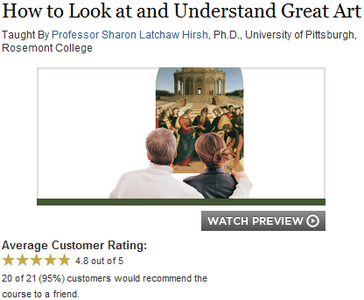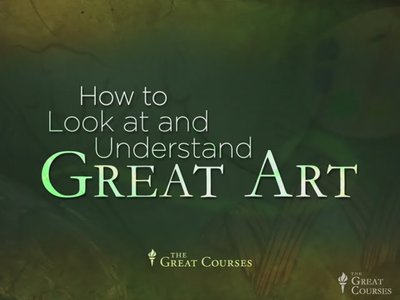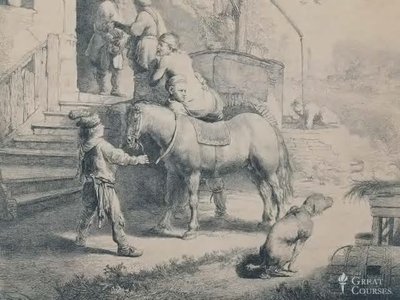How to Look At and Understand Great Art
![]()
![]()
![]()
![]()
![]()
![]()

Code:
How to Look At and Understand Great Art
36xDVDRip | English | WMV | 640 x 480 | WMV3 ~1665 Kbps | 29.970 fps
WMA | 128 kbps | 44.1 KHz | 2 channel | 36 lectures of 30 minutes | 11.5 GB
Genre: eLearning Video / Lectures: Art
Great art is among the most sublime, meaningful, and redeeming creations of all civilization. Few endeavors can equal the power of great artwork to capture aesthetic beauty, to move and inspire, to change your perceptions, and to communicate the nature of human experience.
Great art is also complex, mysterious, and challenging. Filled with symbolism, cultural and historical references, and often visionary imagery, great artworks oblige usdefy us, evento reckon with their many meanings.
What does it take to truly know what you're seeing when you look at art? What technical skills and knowledge are needed to comprehend the full richness of artworks, to unpack the hidden significance of master paintings, sculptures, prints, and more?
Award-winning Professor Sharon Latchaw Hirsh of Rosemont College speaks to these and other compelling questions in How to Look at and Understand Great Art. Unlike a traditional survey of art, these 36 richly illustrated lectures take you on an in-depth exploration of the practical skill of viewing art through the lenses of line, light, perspective, composition, and other crucial elements of craft and technique. Using timeless masterpieces of Western painting, sculpture, and graphic art, as well as hands-on studio demonstrations, Professor Hirsh gives you the specific visual and interpretive knowledge you need to approach great artworks, find their deeper meanings, and reach startling new levels of appreciation.
Discovering the Artist's Visual Language
In building your viewing skills, the opening lectures give you practice with the core technical tools for understanding visual art:
Color: You study the essential principles of color and color schemes in painting and graphic art and the distinctive use of color in different epochs, all of which are deeply integral to an artist's work.
Line: You investigate the artist's use of line (the basis of art) as it describes reality, conveys expressive meaning, and gives larger structural impact to an artwork.
Composition: You learn how the artist constructs a work's overall composition in painting, graphic art, and sculpture. You discover compositional features such as symmetry/asymmetry, balance, and the visual framing of images, as keys to an artwork's comprehensive impact.
Signs and symbols: You learn how to recognize symbolism and signifiers in religious paintings, "vanitas" still lifes, canvases of royalty, and seminal works by Gauguin and Dali.
Rich and Varied Genres of Art
Traveling deeply into the artist's world, you investigate the major genres of drawing, printmaking, sculpture, and painting. You apply your technical knowledge to major works in each genre, exploring the various purposes and types of drawings, the vast spectrum of sculpture and three-dimensional art, and the important traditions within painting and printmaking, with particular attention to how works of art are made.
Here, Professor Hirsh takes you out of the classroom and into the studio, in a series of hands-on demonstrations you rarely find in an academic art course. In the lectures on painting, for example, you study the techniques of fresco and panel painting, and you see oil painting demonstrated, including the mixing of colors, the application of opaque oils and translucent glazes, and the texturing techniques of impasto and scumbling used so memorably by Rembrandt, Van Gogh, and the Expressionists.
In the complex genre of printmaking, you watch a contemporary artist create original prints, showing you the methods of woodcut, copper plate engraving, etching, lithograph, and silkscreen prints. Your understanding of the techniques of printmaking helps you identify the type of print you're looking atoften tricky even for experienced eyesand gives you an appreciation of the craft underlying master prints by Dürer, Doré, Whistler, Degas, and others.
To deepen your insight into subject matter in art, additional lectures are devoted to the importance of landscapes, portraits, and self-portraits.
Great Eras, Visionary Movements
In the course's final section, you use your newfound skills to explore the major eras and movements in Western art, from the Renaissance to the present. In this unfolding progression, you encounter the stunning diversity of artworks from the early Renaissance to the Baroque and Rococo, from 19th-century Romanticism to Impressionism, from 20th-century Expressionism to Cubism, Surrealism, and Modernism, and finally to Postmodernism and the art of our own times.
The knowledge you've developed allows you to recognize and appreciate the dramatic evolution of art, not merely in historical terms, but through specific understanding of how artists work.
In the Limbourg brothers' Hours of the Duc de Berry (15th century), for example, you see their attempt at linear and aerial perspective; later, you see how these techniques were gloriously perfected by Masaccio, Leonardo, and other Renaissance masters. You observe how the impact of El Greco's Mannerist masterpiece Pentecost rests on an anti-Renaissance elongation of figures, unusual poses, and use of tertiary colors.
Of huge value for appreciating modern and contemporary works, you delve into the human experiences and ways of thinking that gave birth to abstract and nonrepresentational art. Here, you study influences such as the three phases of Cubism, the ideas of Kandinsky, and the penetrating imagery of Franz Marc, following the bold and thoughtful moves that freed art from imitating nature. This understanding allows you to grasp the inspiration and visions of De Kooning, Miró, Giacometti, Pollock, and other masters of the modern era.
A Visually Rich Learning Experience
Drawing on works from public and private collections, this course brings masterpieces from more than 250 of the world's greatest artists together in one placemaking this thrilling course a virtual museum of art you won't be able to find anywhere else. Professor Hirsh's lectures come complete with
more than 950 works of art, presented in crisp high-definition that allows you to zoom in and explore their tiniest details;
meticulously crafted 3-D animations that reconstruct particular works;
on-set demonstrations that explain specific painting methods and techniques; and
visits to an actual artist's studio where you get a first-hand look at the secrets of printmaking.
Winner of the Charles A. Dana Award for Distinguished Teaching, Professor Hirsh combines a remarkable breadth of knowledge and a gift for demystifying both the imagery and the motives of art, leaving you with lasting insight into classic masterpieces as well as challenging contemporary works.
By teaching you the artist's visual language and how to "read" it, How to Look at and Understand Great Art gives you an extraordinary key to the full, unforgettable richness of great artworkstheir ability to open you up to new ways of seeing, to bring alive the majestic unfolding of history, and to reveal human experience in all its vividness, poignancy, and dynamic life.
Lectures:
01. The Importance of First Impressions.wmv
02. Where Am I Point of View and Focal Point.wmv
03. ColorDescription, Symbol, and More.wmv
04. LineDescription and Expression.wmv
05. Space, Shape, Shade, and Shadow.wmv
06. Seeing the Big PictureComposition.wmv
07. The IllusionGetting the Right Perspective.wmv
08. Art That Moves UsTime and Motion.wmv
09. Feeling with Our EyesTexture and Light.wmv
10. DrawingDry, Liquid, and Modern Media.wmv
11. PrintmakingRelief and Intaglio.wmv
12. Modern PrintmakingPlanographic.wmv
13. SculptureSalt Cellars to Monuments.wmv
14. Development of PaintingTempera and Oils.wmv
15. Modern PaintingAcrylics and Assemblages.wmv
16. Subject Matters.wmv
17. SignsSymbols, Icons, and Indexes in Art.wmv
18. PortraitsHow Artists See Others.wmv
19. Self-PortraitsHow Artists See Themselves.wmv
20. LandscapesArt of the Great Outdoors.wmv
21. Putting It All Together.wmv
22. Early RenaissanceHumanism Emergent.wmv
23. Northern RenaissanceDevil in the Details.wmv
24. High RenaissanceHumanism Perfected.wmv
25. Mannerism and BaroqueDistortion and Drama.wmv
26. Going BaroqueNorth versus South.wmv
27. 18th-Century Reality and Decorative Rococo.wmv
28. RevolutionsNeoclassicism and Romanticism.wmv
29. From Realism to Impressionism.wmv
30. PostimpressionismForm and Content Re-Viewed.wmv
31. ExpressionismEmpathy and Emotion.wmv
32. CubismAn Experiment in Form.wmv
33. AbstractionModernismNew Visual Language.wmv
34. Dada Found ObjectsSurreal Doodles and Dreams.wmv
35. PostmodernismFocus on the Viewer.wmv
36. Your Next Museum VisitDo It Yourself!.wmv



Code:
http://isavelink.com/k4tay2z567aw
http://isavelink.com/76b147tsmimm
http://isavelink.com/887zh4p7ks39
http://isavelink.com/aw5hz4fke3d0
http://isavelink.com/icv34f4d4k3g
http://isavelink.com/9h1w83j9nnwy
http://isavelink.com/sjf8o6m30f25
http://isavelink.com/9180n4cl35tk
http://isavelink.com/1b8bair8abw1
http://isavelink.com/0mr69cxqf2g9
http://isavelink.com/52ed5bawjhfy
http://isavelink.com/j2wm668ev8hh
http://isavelink.com/ob3sdmynxs3q
http://isavelink.com/2s2lau06t714
http://isavelink.com/m5ao7fd0od8b
http://isavelink.com/v83o7t4ac1mu
http://isavelink.com/ajoex7k72oz4
http://isavelink.com/5dd03jgluib2
http://isavelink.com/gq702bgqrvdv
http://isavelink.com/vuacbw1kzr9d
http://isavelink.com/x5o8f48rg67a
http://isavelink.com/b0vr80pbrcbe
http://isavelink.com/h2v3m205tufs
http://isavelink.com/65efwv1lcs6n
http://isavelink.com/3x7kxz2qqot3
Code:
feedurbrain.com